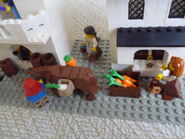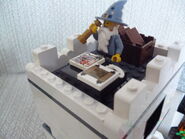| Customs Article This article describes a custom creation, custom theme, or other fan material, made by a Brickipedia contributor. It has never been, is not, and will not be officially released. |
Nativity Scene is a custom set created by Szrz to celebrate Christmas.
Description[]
In a crude barn occupied by an ox and a donkey in the outskirts of Bethlehem Jesus the son of Mary was born. The young mother placed her baby in the manger. He is looked after by Mary’s husband Joseph and adored by an angel.
The very night a group of shepherds, who had been camping nearby, had been woken up by the angel. The divine messenger told them to abandon their flocks and go to the barn to see their newborn king, so they came with provisions and a song. Also a group of female villagers joined them.
The three kings came from the East led by a mysterious traveling star. They left their palfreys with a servant and offered the newborn Jesus mighty gifts of gold, frankincense and myrrh.
The citizens of Bethlehem seems to be unaware of the events. In the house on the left a wine dealer is chatting with his regular customer and a traveling merchant, while his wife is combing her hair in the room above. In the house on the opposite side of the narrow alley a shopkeeper is selling food to a wealthy lady. There is also a servant girl carrying two buckets of water and an astrologist observing a strange star from his workshop on the roof.
Background[]
The Nativity scene depicts the birth of Jesus described in the New Testament of the Bible. It is usually a cave or a barn containing figures of the Holy Family, the three kings offering gifts, as well as angels, shepherds with their flocks and some farm animals, such as an ox and a donkey. The Nativity scenes were introduced and popularized in the Middle Ages by Franciscan monks. The tradition of making such scenes is a part of the Christmas tradition in many Christian communities, where they are displayed annually in churches, town squares and private houses from December till the beginning of February.
The scenery may wary from very simple constructions with just three figures to the elaborated and detail miniature towns with many additional buildings and stunt characters. The artistic vision may follow the details of the Holy Land landscape or include anachronistic or even contemporary elements.













